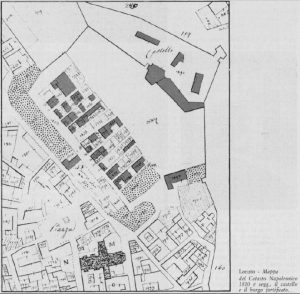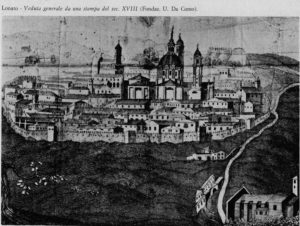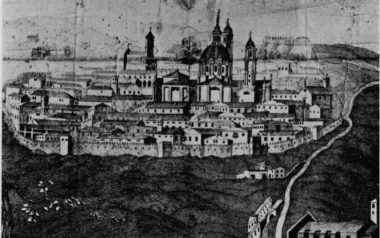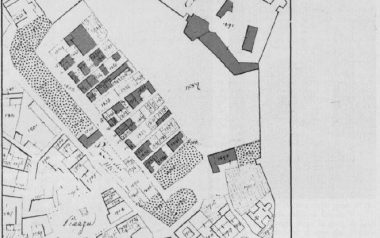History of Lonato del Garda
History of Lonato del Garda from the twelfth century to the end of the eighteenth, from the lordships to the end of the Serenissima Republic of Venice.
The History of Lonato del Garda as told by Fausto Lechi in his”Dimore bresciane”: “When, at the beginning of the 13th century, the two rival factions of the city raged in Brescia “societas militum” and of “societas Sancti Faustini” the head of the first, Alberto dei conti di Casaloldo, driven out of his own by the city retired to Lonato and from here did not stop harassing Brescia until the bishop Alberto ordered Lotaringo Martinengo to snid him from this castle that he occupied without any rights. Lonato and the whole Riviera suffered serious damage from the raids of Pinamonte Bonacolsi, when he became lord of Mantua in the cause of the “madness of Casaloldi” driving Alberto out of that family, former lord. In the fourteenth century, during the struggles of the seigniories, he passed from Bernabò Visconti (1354) to Cansignorio della Scala (1362), a treacherous friend of the Brescian Guelfs, to return under the Visconti (1364). In 1339, during the struggle between Mastino della Scala and Azzone Visconti, the Fortress was devastated by the German bands in the pay of Lodrisio Visconti under the Scaligero. The church of S. Zeno was largely destroyed with the fortress, which according to Cenedella was at least four times larger than the present church. Those ranks advancing towards the more recent part of Lonato completely ruined the strong village so Azzone in March of that year raised the Lonatesi from many leaps and bounties. The widow of Azzone, Luchino and Gio, Visconti, take away Lonato from Brescia, and pitying “Lonadum dilectam terram nostram per scelerosam teutonicam gentem invasum et combustum”, ordinano “ut homines de Calcinado concurrant etiam cum bobus e plustris ad moenia Lonadi aedificanda”.
With the brief Visconti domain appears for the first time in Lonato the figure of a soldier in charge of the defense of the castle “the captain”, which meant the importance of the place as a fortress, above the rights of the community. The Lordship of the Visconti ceased when Caterina widow of Gian Galeazzo and regent in the name of her sons, yielded in 1404 Lonato, with Castiglione, Solferino and Castelgoffredo, to Francesco Gonzaga who was the creditor of 650,000 imperial lire. In the same way Brescia was sold to Pandolfo Malatesta. Those lands were confirmed at the Gonzaga, when Venice, after the death of Carmagnola, entrusted its army to this unsound leader; while the Commune of Lonato were sold by the Gonzzaga half of the properties confiscated from the Foccacci and so began the ruin of Castel Venzago. In the summer of 1440, the Gonzaga had to yield Lonato and other castles of the Mantuan to Francesco Sforza and then, definitively, following the Cavriana treaty between the “villano” condottiero and Venice, to the latter, but as compensation he was in possession of the castle of Ostiglia. With the peace and the return to Venice a certain tendency re-appeared to want to detach from Brescia, as well as Chiari, Salò and Valcamonica and other minor centers. How downright over the centuries were these aversions of small centers against the main center, so widespread throughout Italy. In 1454 Giacomo Piccinino, son of Nicolò, condottiero now in the pay of Venice, in his last war action before the peace of Lodi, occupied Lonato and allowed his troops to plunder him without mercy. It was a terrible fact that moved all the populations of the two provinces concerned in Brescia and Verona, in which funds were raised to help those of Lonato. Benefits were given after the peace of Lodi (1454) and I believe that it was after that Venice was concerned with improving the fortifications of the castle of Lonato, which had been elevated to the rank of minor Podesta, like Chiari and Palazzolo (the biggest were Salò , Asola, Breno and Orzinuovi). The Podestà, a nobleman from Brescia, had the civil jurisdiction and also the criminal one “without blood pains”, but with the license to “give the rope”. Concerned about keeping this castle in efficiency, Venice thought of appointing you a provider who was a real castellan, then provident to renew the fortifications that, however, it seems, were always entrusted to the citizens and a weak Venetian garrison under the orders of that administrator, who had the responsibility for the defense. Now the castle of Lonato, although not having the characteristics of a real stronghold such as Orzinuovi, for the position of its fortress well defended by very steep terrain on three sides, can withstand attacks from possible enemies. These were not long in coming, during the war of Ferrara and when the troops of the Duke of Calabria presented themselves under the walls (September 1483) Lonato, who had been rescued by men who had come from Brescia, was able to resist validly, as did nearby Bedizzole. In the sad May 1509, which saw the infatuation of the Brescians for the French survivors of Louis XII, Lonato was abandoned by the Venetians and on the 28th of that month saw the king of France pass by with his splendid cortege, who left a garrison with great disappointment of the Marquis of Mantua always aspiring to occupy Lonato or Peschiera and always disappointed. But, as in Brescia, even here there was little favor for the French and in 1510 the Lonates rose up, but the uprising was stifled in the blood and the occupants destroyed, in revenge, an entire district of the country. Having left the French and succeeded the Spaniards of Cardona, even Lonato suffered from the looting of those mixed troops of Spaniards and Germans of every ream; so they made great welcome to Isabella d’Este who in 1513 went to visit the villages of the lower Garda, always in spernza to gather friendships and sympathy for the Gonzagas. Isabella’s enthusiasm is expressed in the description given to her husband for the vast panorama that she enjoys from the fortress, for her too much use to the panoramic views of Ferrara and Mantua: “…. but I will tell him well that I never saw a more beautiful place than that, and I took a great walk and recreatione to make me name the infinite lands that if they see …”. It was then the turn of the Germans who lingered around Lonato until the spring of 1516 when Brescia was liberated. These imperial troops again became “cum grande ruina” when they passed in 1529 and, besides cutting the populations, they also wanted to dismantle the fortress of Lonato. After these facts of the city war, which over the years had grown larger, falling apart from the old “castrum” and reaching the last ridge towards the plain, it was conveniently surrounded by walls in which, given the roughness of the terrain, they opened only three gates: the eastern one towards Desenzano, the western one towards Brescia and the one to the north, leading to the drugolo campaign, and then to all the towns and communication routes of the Rivieera up to Gavardo and Val Sabbia. By now, with the changed rules of war, the importance of the stronghold diminishes, the importance of the walled city increases, with its old castle within which a small garrison of “ordinances” will find accommodation. This did not help to avoid that during the war for the Monferrato (1628) fortress and city were turned into a parade ground with infinity of damaging to the population, and that between 1701 and 1704 they harmed both the castle and the city, both armies and in dramatic comings and goings they roamed for our porvincia during the war of succession of Spain.
Now even the old fortress was ruining, so at least reports in a report the Prov. F. Tiepolo in 1734, where he reports that the soldiers’ lodgings are badly reduced. When in July-August 1796 the French and Austrian armies reappeared under Lonato, no mention is made of the castle. At present, the real fortress is reduced to complete ruin; the perimeter of the walls is still well marked as far as it is bruised here and there, but the buildings that had been built for the shelter of the troops have disappeared and the rest is in the conditions that we have described. ”
History of Lonato del Garda




